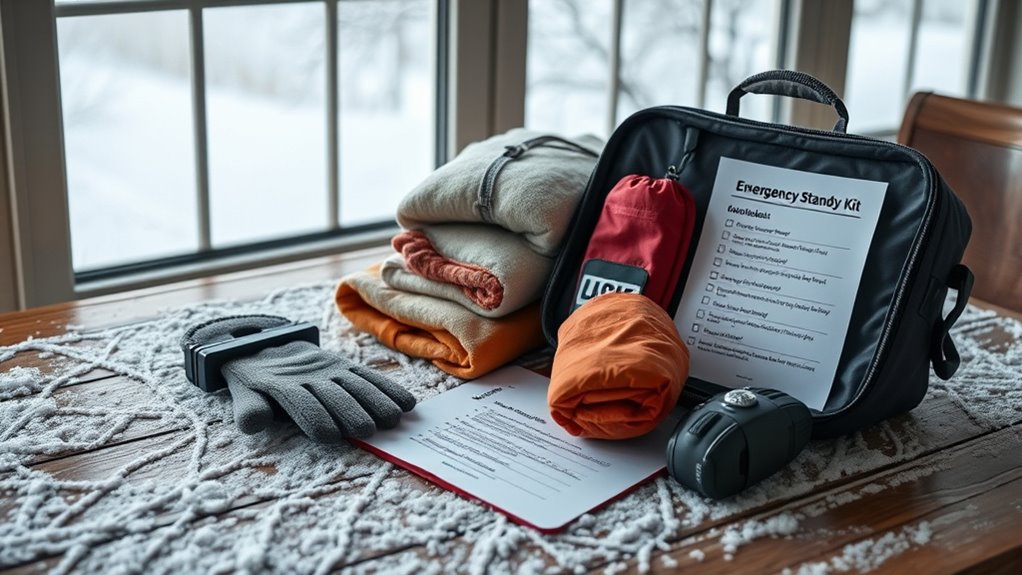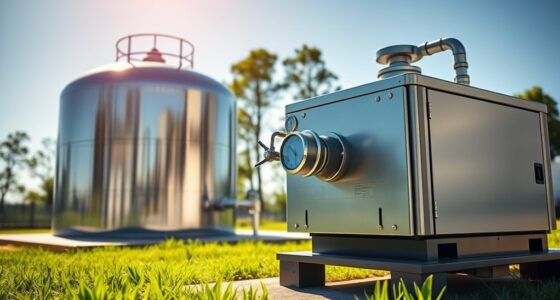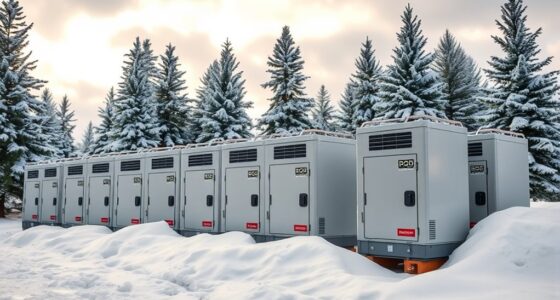Before you start assembling cold weather kits for your standby units, it’s important to know that not all components are equally effective, and many myths surround insulation, heating, and batteries. Good insulation combined with reliable heating keeps your system working even in freezing temperatures. Proper maintenance, like checking batteries and fuel supplies, prevents failures. Understanding these facts guarantees you don’t fall for common misconceptions—keep going to uncover the key details for winter readiness.
Key Takeaways
- Proper insulation combined with reliable heating prevents freezing and reduces energy costs for standby units.
- Not all components in cold weather kits are sufficient; regular maintenance ensures system reliability.
- Batteries with high cold tolerance and insulation improve performance in low temperatures.
- Frost protection alone does not replace the need for insulation and heating solutions.
- Regular checks of fuel, batteries, and solar panels are essential to prevent system failures during winter.
Common Misconceptions About Cold Weather Kit Components
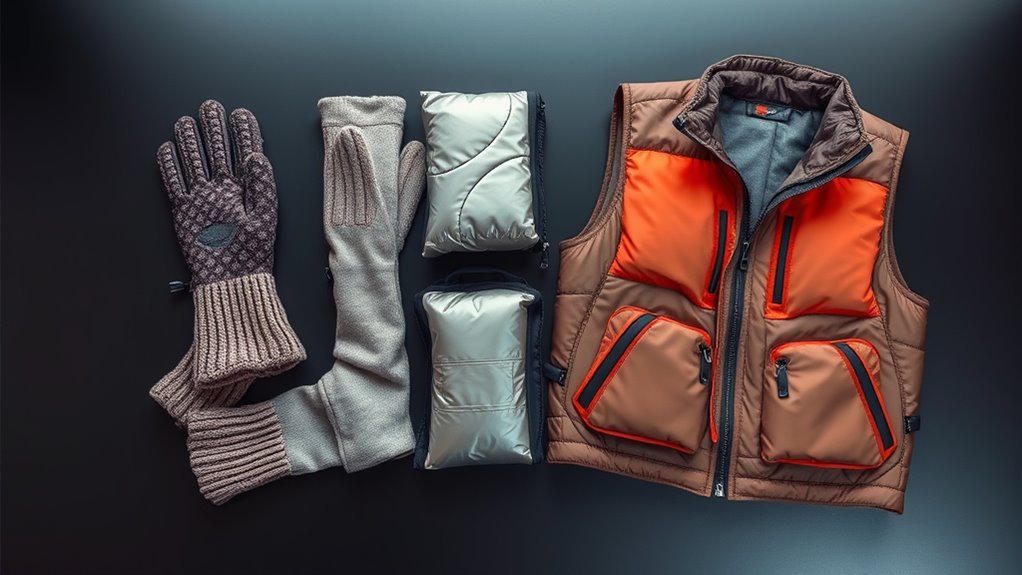
Many people assume that cold weather kit components are all you need to keep standby units operational in winter conditions. However, frost protection and moisture barriers are often misunderstood or overlooked. Frost protection helps prevent freezing of critical parts, but it doesn’t eliminate the need for proper insulation. Moisture barriers are essential to prevent condensation and water intrusion, which can cause rust and damage. Relying solely on basic components without considering these factors can lead to system failures. Proper frost protection techniques include using heated enclosures or thermostatically controlled heating pads, while moisture barriers ensure that moisture doesn’t compromise your equipment. Understanding that these elements work together is key to maintaining reliable standby units during cold weather. Additionally, proper insulation can significantly enhance the effectiveness of frost protection measures by reducing heat loss and maintaining consistent temperatures around critical components.
The Truth About Insulation and Heating Solutions

Have you ever wondered if your insulation and heating solutions are truly effective for keeping standby units operational in cold weather? The truth is, insulation effectiveness varies based on material quality and installation. Good insulation reduces heat loss, helping your equipment stay warm without over-reliance on heating technology. Modern heating solutions, like electric heaters or heat tapes, can supplement insulation but aren’t a substitute for proper insulation measures. Relying solely on heating technology without adequate insulation might lead to higher energy costs and inconsistent performance. To ensure your standby units remain operational, combine high-quality insulation with reliable heating solutions. This layered approach optimizes insulation effectiveness and ensures your equipment stays protected, regardless of how low the temperatures drop. Additionally, understanding the role of ethical hacking can help you identify vulnerabilities in your systems, ensuring your emergency equipment remains secure and functional during cold weather scenarios.
Myths Surrounding Battery Performance in Cold Conditions
While proper insulation and heating solutions help keep standby units warm, misconceptions about battery performance in cold weather persist. Many assume cold reduces battery life drastically or that batteries lose all cold resistance. In reality, batteries can maintain performance with proper cold weather kits. Cold resistance varies among battery types, and some are designed specifically for low temperatures. The key is understanding that cold can slow chemical reactions inside the battery, affecting power output temporarily. Using insulation, heating pads, or thermal wraps can improve cold resistance, ensuring your battery performs reliably. Additionally, selecting batteries with high cold tolerance can further enhance performance in low temperatures.
Debunking Cold Weather Kit Maintenance and Usage Myths
Despite common beliefs, proper maintenance and correct usage of cold weather kits are essential for reliable standby unit operation, and misconceptions can lead to neglect or improper handling. For example, some think solar backups don’t need winter checks, but cold weather can reduce their efficiency. Proper fuel storage is also critical; storing fuel in unprotected tanks can cause gelling or freezing, impairing supply. Regularly inspecting and maintaining your kit ensures components like batteries, fuel lines, and solar panels function at their best. Avoid neglecting these tasks, as it might mean your system fails when you need it most. Clear understanding and diligent upkeep prevent costly failures and ensure your standby unit performs reliably in cold conditions. Proper maintenance is your best defense against cold weather surprises. Understanding fan culture can also help in managing community expectations and ensuring support systems remain reliable during winter.
Essential Facts for Proper Cold Weather Kit Selection
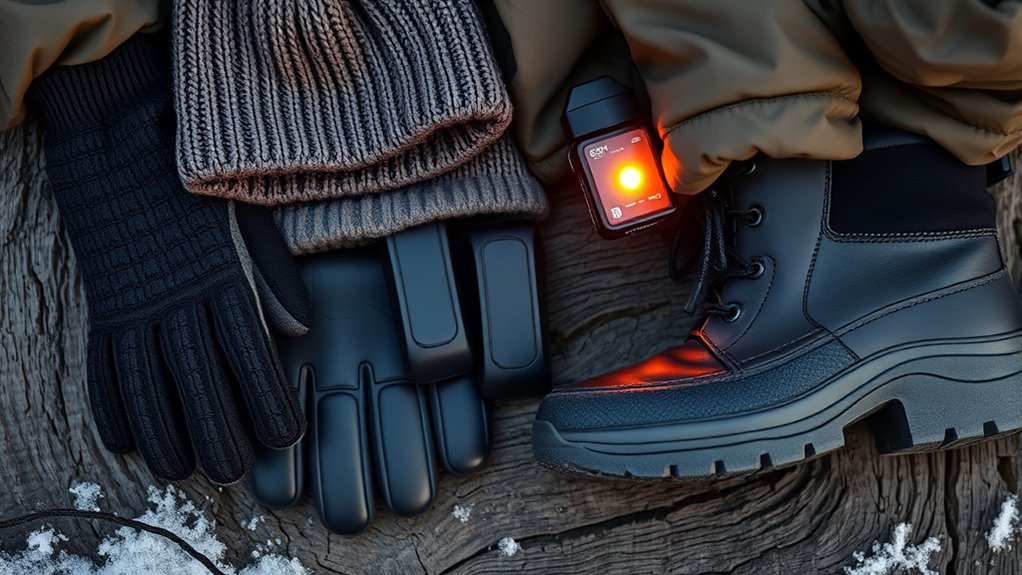
Selecting the right cold weather kit is crucial to guarantee your standby units operate reliably in low temperatures. To do this, focus on thermal insulation options that prevent heat loss and maintain consistent temperatures. Proper thermal insulation ensures your units stay protected without excessive energy use. Additionally, consider portable heaters that can provide supplemental warmth when needed, especially in extreme cold. These heaters should be safe, easy to operate, and compatible with your system’s power supply. Avoid kits that lack adequate insulation or rely solely on external heating sources, as they may be ineffective or unsafe. By choosing a kit with appropriate thermal insulation and reliable portable heaters, you ensure your standby units remain functional, reducing downtime and preventing cold-related damage. Aura techniques can also help you monitor and optimize your system’s performance in cold weather conditions.
Frequently Asked Questions
How Do I Determine the Right Size of Cold Weather Kit for My Unit?
You determine the right size of a cold weather kit by doing a size assessment based on your unit’s specifications and operational needs. Consider factors like the unit’s size, location, and typical cold exposure. Kit customization is key—adding or removing components ensures maximum protection. Evaluate your environment and usage patterns carefully, and consult with suppliers to tailor a kit that fits perfectly, providing effective cold weather protection without unnecessary bulk.
Are There Specific Brands Recommended for Cold Weather Standby Kits?
You should look for brand recommendations known for quality and durability, like Caterpillar, Briggs & Stratton, or Cummins. These brands offer reliable cold weather standby kits that can often be tailored to fit your specific unit. Customization ensures your kit contains the right components for your climate and equipment needs. Always choose trusted brands to ensure performance, especially in harsh winter conditions, and consult with suppliers for personalized kit options.
How Often Should Cold Weather Kits Be Inspected or Replaced?
Think of your cold weather kit as a garden that needs regular tending. You should inspect it at least twice a year, preferably before winter hits, to guarantee everything is in working order. Follow the recommended maintenance schedules and storage guidelines to keep your kit ready when needed. Replace expired or damaged items promptly, so your standby units stay prepared to weather any storm.
Can Portable Heaters Be Safely Used With Standby Units in Cold Weather?
You can safely use portable heaters with standby units if you prioritize portable heater safety and confirm compatibility. Always check that the heater is rated for continuous operation in industrial settings, and verify that it won’t interfere with your standby unit’s operation. Keep the heater away from combustible materials, and follow manufacturer instructions carefully. Proper setup and regular inspections help maintain safety and ensure your standby unit remains reliable during cold weather.
What Are the Signs Indicating My Cold Weather Kit Is Underperforming?
You’ll notice your cold weather kit is underperforming if it struggles to start the standby unit or if the battery fails prematurely. Fuel gelling can block fuel lines, causing power loss. These signs suggest your kit isn’t ready for harsh conditions, so check the battery’s health regularly and use fuel additives to prevent gelling. Staying vigilant helps make certain your standby unit remains reliable despite cold weather challenges.
Conclusion
Don’t let myths freeze your preparedness. Think of your cold weather kit as a trusted guardian, shielding you through winter’s harshest whispers. By knowing the truths and dispelling the misconceptions, you’re armoring yourself with confidence and resilience. When the cold winds blow, you’ll stand firm, your kit a beacon of warmth and safety. Embrace the facts, and let your readiness shine brighter than any winter sun—because staying safe starts with knowing the real story.
